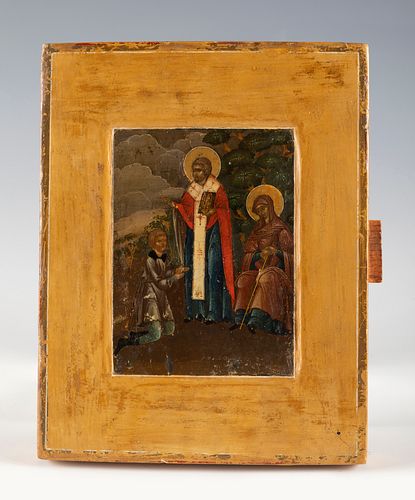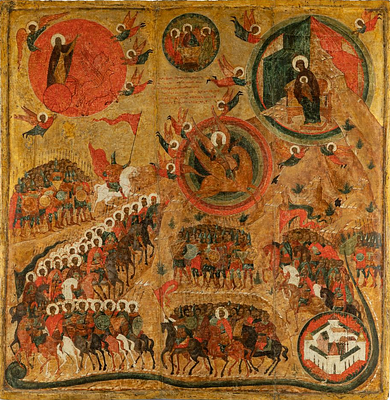School of Mstera, 18th century. "Conversation with the Mother of God". Tempera, gold leaf on panel.
Lot 56
About Seller
Setdart Auction House
Carrer Aragó 346
Barcelona
Spain
Setdart Subastas was born in 2004 and is currently the first online art auction in Spain with solidity, prestige and reliability guaranteed by our more than 60,000 users. Setdart has a young, dynamic and enterprising team ready to successfully manage the purchase and sale of art works through custom...Read more
Estimate:
EUR€700 - EUR€800
$721.65 - $824.74
Absentee vs Live bid
Two ways to bid:
- Leave a max absentee bid and the platform will bid on your behalf up to your maximum bid during the live auction.
- Bid live during the auction and your bids will be submitted real-time to the auctioneer.
Bid Increments
| Price | Bid Increment |
|---|---|
| EUR€0 | EUR€10 |
| EUR€200 | EUR€25 |
| EUR€500 | EUR€50 |
| EUR€1,000 | EUR€100 |
| EUR€3,000 | EUR€200 |
| EUR€5,000 | EUR€500 |
| EUR€10,000 | EUR€1,000 |
| EUR€20,000 | EUR€2,000 |
| EUR€50,000 | EUR€5,000 |
About Auction
By Setdart Auction House
Sep 23, 2021
Set Reminder
2021-09-23 10:00:00
2021-09-23 10:00:00
America/New_York
Bidsquare
Bidsquare : RUSSIAN ICONS
https://www.bidsquare.com/auctions/setdart-auction-house/russian-icons-7431
Setdart Auction House sofia@setdart.com
Setdart Auction House sofia@setdart.com
- Lot Description
School of Mstera, 18th century. "Conversation with the Mother of God". Tempera, gold leaf on panel. Measurements: 15 x 12 cm. The conversation with the Mother of God is a particular typology of the icons of the Mother of God, venerated in the Orthodox Church. The three characters represented in this miniature are the seated Mother of God, Saint Nicholas the Miracle-Maker, and the acñolito Georgiy Yurish. The Mother of God appears in front of the acolyte right on the site where the church was to be built, where the icon of the Mother of God of Tikhvin was later found in 1383. According to tradition, the Virgin Mary appeared and ordered that a wooden cross be placed on the dome of the church, rather than a metal one. The Virgin Mary appeared together with St. Nicholas, who promised to give a sign to the infidels. The request of the Virgin Mary was not carried out and the master, Georgiy Yurish, who was trying to put up the metal cross, was caught by a gust of wind, which blew him to the ground unharmed. A wooden cross was then placed in the church, as indicated by the Madonna. This icon follows the iconographic typology of the story, but with certain modifications. The Mother of God is shown seated, although she is not seen in this image, according to tradition, on the trunk cut out of wood. Behind her is a tree in full growth with large leaves. In her arms she holds a black hygumen rod, which in the case of the auctioned icon is gilded. In front of the Virgin is a kneeling man in a posture of prayer. Between them is Saint Nicholas, who does not follow his canonical representation, as the type of beard and hair is different from the traditional one. This icon was produced in the workshops of Mstera, one of the most important icon-painting schools in Russia, both in terms of the quantity and quality of its production. This village is located near Vladimir, another of the most important icon-painting schools, and the first mentions of it date from around 1628. It was a poor location, and its inhabitants, mainly peasants, alternated their farming activities with various crafts for a living. Since Mstera was surrounded by monasteries and churches, icon painting was the most common activity. Thus, by the 19th century, more than half of the population was engaged exclusively in icon painting. The speciality of this school was to follow the ancient styles, its icons are distinguished by the abundance of details, both in the depiction of saints and in the representation of nature, but at the same time the aesthetics of the characters could be described as naïve. Apart from painting icons en masse, the masters of Mstera were also first-rate restorers.
- Shipping Info
-
In-house shipping available. Please inquire at admin@setdart.com.
-
- Buyer's Premium



 EUR
EUR CAD
CAD AUD
AUD GBP
GBP MXN
MXN HKD
HKD CNY
CNY MYR
MYR SEK
SEK SGD
SGD CHF
CHF THB
THB















